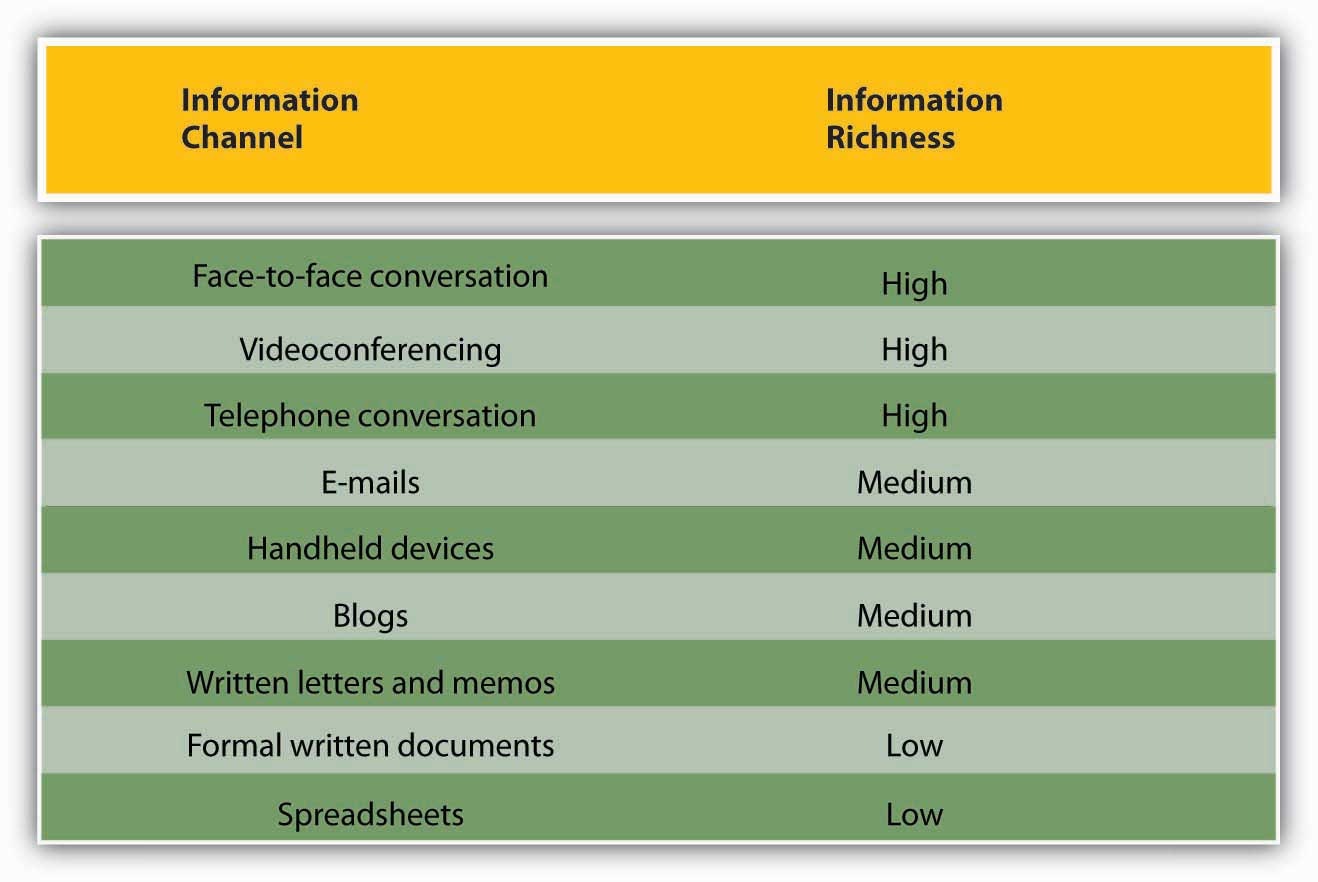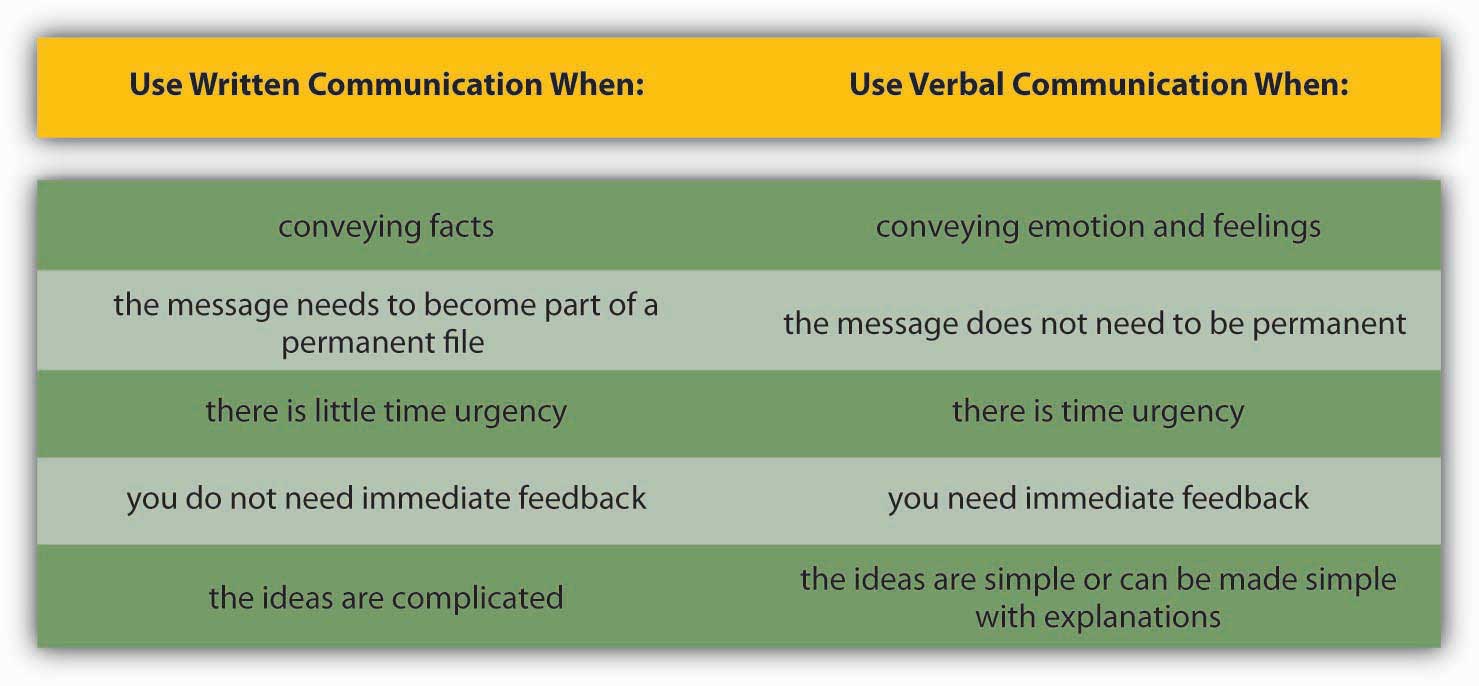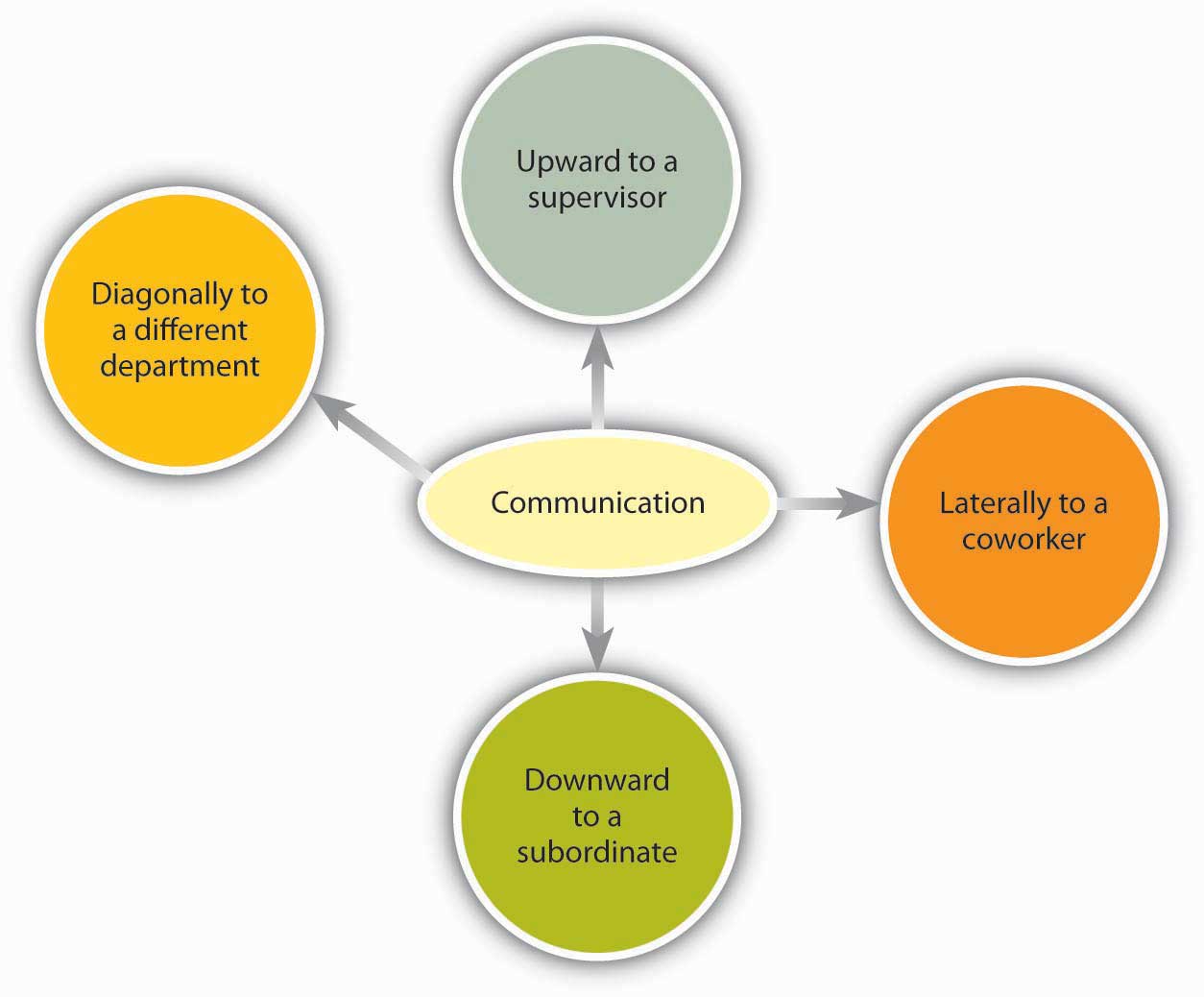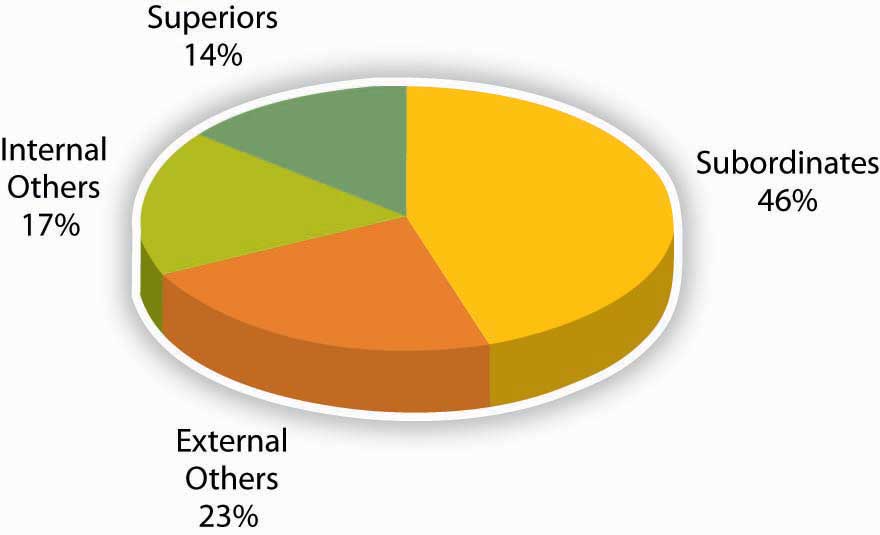12.6 Communication Channels
Learning Objectives
- Understand how communication channels affect communication.
- Recognize different communication directions within organizations.
The channel, or medium, used to communicate a message affects how accurately the message will be received. Verbal, written, and nonverbal communications have different strengths and weaknesses. In business, the decision to communicate verbally or in written form can be a powerful one. In addition, a smart manager is aware of the nonverbal messages conveyed by either type of communication—as noted earlier, only 7% of verbal communication comes from the words themselves.
Information Richness
Channels vary in their information richness. Information-rich channels convey more nonverbal information. As you may be able to guess from our earlier discussion of verbal and written communications, verbal communications are richer than written ones. Research shows that effective managers tend to use more information-rich communication channels than less effective managers (Allen & Griffeth, 1997; Fulk & Boyd, 1991; Yater & Orlikowski, 1992). The figure below illustrates the information richness of different information channels.
Figure 12.16 Information Richness
Adapted from information in Daft, R. L., & Lenge, R. H. (1984). Information richness: A new approach to managerial behavior and organizational design. In B. Staw & L. Cummings (Eds.), Research in organizational behavior (Vol. 6, pp. 191–233). Greenwich, CT: JAI Press; and Lengel, R. H., & Daft, D. L. (1988). The selection of communication media as an executive skill. Academy of Management Executive, 11, 225–232.
Like face-to-face and telephone conversation, videoconferencing has high information richness because Receivers and Senders can see or hear beyond just the words—they can see the Sender’s body language or hear the tone of their voice. Handheld devices, blogs, and written letters and memos offer medium-rich channels because they convey words and pictures/photos. Formal written documents, such as legal documents, and spreadsheets, such as the division’s budget, convey the least richness because the format is often rigid and standardized. As a result, nuance is lost.
In business, the decision to communicate verbally or in written form can be powerful. In addition, a smart manager is aware of the nonverbal messages conveyed by either type of communication—as noted earlier, only 7% of a verbal communication comes from the words themselves.
When determining whether to communicate verbally or in writing, ask yourself: Do I want to convey facts or feelings? Verbal communications are a better way to convey feelings. Written communications do a better job of conveying facts.
Picture a manager making a speech to a team of 20 employees. The manager is speaking at a normal pace. The employees appear interested. But how much information is being transmitted? Not as much as the speaker believes! Humans listen much faster than they speak. The average public speaker communicates at a speed of about 125 words a minute. And that pace sounds fine to the audience. (In fact, anything faster than that probably would sound weird. To put that figure in perspective, someone having an excited conversation speaks at about 150 words a minute.) On the basis of these numbers, we could assume that the employees have more than enough time to take in each word the manager delivers. And that’s the problem. The average person in the audience can hear 400–500 words a minute (Lee & Hatesohl, 2008). The audience has more than enough time to hear. As a result, they will each be processing many thoughts of their own, on totally different subjects, while the manager is speaking. As this example demonstrates, oral communication is an inherently flawed medium for conveying specific facts. Listeners’ minds wander! It’s nothing personal—in fact, it’s totally physical. In business, once we understand this fact, we can make more intelligent communication choices based on the kind of information we want to convey.
The key to effective communication is to match the communication channel with the goal of the communication (Barry & Fulmer, 2004). For example, written media may be a better choice when the Sender wants a record of the content, has less urgency for a response, is physically separated from the Receiver, doesn’t require a lot of feedback from the Receiver, or the Message is complicated and may take some time to understand. Oral communication, however, makes more sense when the Sender is conveying a sensitive or emotional Message, needs feedback immediately, and does not need a permanent record of the conversation. Use the guide provided for deciding when to use written versus verbal communication.
Business Use of E-Mail
The growth of e-mail has been spectacular, but it has also created challenges in managing information and an ever-increasing speed of doing business. Over 100 million adults in the United States use e-mail regularly (at least once a day) (Taylor, 2002). Internet users around the world send an estimated 60 billion e-mails every day, and many of those are spam or scam attempts (CNET, 2006). That makes e-mail the second most popular medium of communication worldwide, second only to voice. A 2005 study estimated that less than 1% of all written human communications even reached paper—and we can imagine that this percentage has gone down even further since then (Isom, 2005). To combat the overuse of e-mail, companies such as Intel have even instituted “no e-mail Fridays” where all communication is done via other communication channels. Learning to be more effective in your e-mail communications is an important skill. To learn more, check out the business e-mail do’s and don’ts.
Business E-Mail Do’s and Don’ts
- DON’T send or forward chain e-mails.
- DON’T put anything in an e-mail that you don’t want the world to see.
- DON’T write a Message in capital letters—this is the equivalent of SHOUTING.
- DON’T routinely “cc” everyone all the time. Reducing inbox clutter is a great way to increase communication.
- DON’T hit Send until you spell-check your e-mail.
- DO use a subject line that summarizes your Message, adjusting it as the Message changes over time.
- DO make your request in the first line of your e-mail. (And if that’s all you need to say, stop there!)
- DO end your e-mail with a brief sign-off such as, “Thank you,” followed by your name and contact information.
- DO think of a work e-mail as a binding communication.
- DO let others know if you’ve received an e-mail in error.
Source: Adapted from information in Leland, K., & Bailey, K. (2000). Customer service for dummies. New York: Wiley; Information Technology Services (1997). Top 10 email dos and top ten email don’ts. Retrieved July 1, 2008, from the University of Illinois at Chicago Medical Center Web site: http://www.uic.edu/hsc/uicmc/its/customers/email-tips.htm; Kawasaki, G. (2006, February 3). The effective emailer. Retrieved July 1, 2008, from How to Change the World Web site: http://blog.guykawasaki.com/2006/02/the_effective_e.html.
An important, although often ignored, rule when communicating emotional information is that e-mail’s lack of richness can be your loss. As we saw in the chart above, e-mail is a medium-rich channel. It can convey facts quickly. But when it comes to emotion, e-mail’s flaws make it far less desirable a choice than oral communication—the 55% of nonverbal cues that make a conversation comprehensible to a listener are missing. E-mail readers don’t pick up on sarcasm and other tonal aspects of writing as much as the writer believes they will, researchers note in a recent study (Kruger, 2005).
The Sender may believe she has included these emotional signifiers in her Message. But, with words alone, those signifiers are not there. This gap between the form and content of e-mail inspired the rise of emoticons—symbols that offer clues to the emotional side of the words in each Message. Generally speaking, however, emoticons are not considered professional in business communication.
You might feel uncomfortable conveying an emotionally laden message verbally, especially when the message contains unwanted news. Sending an e-mail to your staff that there will be no bonuses this year may seem easier than breaking the bad news face-to-face, but that doesn’t mean that e-mail is an effective or appropriate way to deliver this kind of news. When the Message is emotional, the Sender should use verbal communication. Indeed, a good rule of thumb is that the more emotionally laden messages require more thought in the choice of channel and how they are communicated.
Direction of Communication Within Organizations
Information can move horizontally, from a Sender to a Receiver, as we’ve seen. It can also move vertically, down from top management or up from the front line. Information can also move diagonally between and among levels of an organization, such as a Message from a customer service representative up to a manager in the manufacturing department, or a Message from the chief financial officer sent down to all department heads.
There is a chance for these arrows to go awry, of course. As Mihaly Csikszentmihalyi, author of best-selling books such as Flow, has noted, “In large organizations the dilution of information as it passes up and down the hierarchy, and horizontally across departments, can undermine the effort to focus on common goals.” Managers need to keep this in mind when they make organization design decisions as part of the organizing function.
The organizational status of the Sender can affect the Receiver’s attentiveness to the Message. For example, consider: A senior manager sends a memo to a production supervisor. The supervisor, who has a lower status within the organization, is likely to pay close attention to the Message. The same information, conveyed in the opposite direction, however, might not get the attention it deserves. The Message would be filtered by the senior manager’s perception of priorities and urgencies.
Requests are just one kind of communication in business. Other communications, both verbal or written, may seek, give, or exchange information. Research shows that frequent communications with one’s supervisor is related to better job performance ratings and overall organizational performance (Snyder & Morris, 1984; Kacmar, et. al., 2003). Research also shows that lateral communication done between peers can influence important organizational outcomes such as turnover (Krackhardt & Porter, 1986).
External Communications
External communications deliver specific business messages to individuals outside an organization. They may announce changes in staff or strategy, earnings, and more. The goal of an external communication is to create a specific Message that the Receiver will understand and share with others. Examples of external communications include the following:
Press Releases
Public relations professionals create external communications about a client’s product, services or practices for specific Receivers. These Receivers, it is hoped, will share the Message with others. In time, as the Message is passed along, it should appear to be independent of The Sender, creating the illusion of an independently generated consumer trend, public opinion, and so on.
The Message of a public relations effort may be b2b (business to business), b2c (business to consumer), or media related. The Message can take different forms. Press releases try to convey a newsworthy message, real or manufactured. It may be constructed like a news item, inviting editors or reporters to reprint the Message in part, or as a whole, with or without acknowledgment of the Sender’s identity. Public relations campaigns create Messages over time, through contests, special events, trade shows, and media interviews in addition to press releases.
Ads
Advertising places external business Messages before target Receivers through media buys. A media buy is a fee that is paid to a television network, Web site, or magazine by an advertiser for an on-air, site, or publication ad. The fee is based on the perceived value of the audience who watches, reads, or frequents the space where the ad will appear.
In recent years, Receivers have begun to filter advertiser’s Messages, a phenomenon that is perceived to be the result of the large amount of ads the average person sees each day and a growing level of consumer wariness of paid Messaging. Advertisers, in turn, are trying to create alternative forms of advertising that Receivers won’t filter. The advertorial is one example of an external communication that combines the look of an article with the focused Message of an ad. Product placements in videos, movies, and games are other ways that advertisers strive to reach Receivers with commercial Messages.
Web Pages
A Web page’s external communication can combine elements of public relations, advertising, and editorial content, reaching Receivers on multiple levels and in multiple ways. Banner ads, blogs, and advertiser-driven “click-through” areas are just a few of the elements that allow a business to deliver a Message to a Receiver online. The perceived flexibility of online communications can impart a less formal (and, therefore, more believable) quality to an external communication. A Message relayed in a daily blog post will reach a Receiver differently than if it is delivered in an annual report, for example. The popularity and power of blogs is growing, with 11% of Fortune 500 companies having official blogs (up from 4% in 2005). In fact, blogs have become so important to some companies as Coca-Cola, Kodak, and Marriott that they have created official positions within their organizations titled “Chief Blogging Officer (Workforce, 2008).”
The “real-time” quality of Web communications may appeal to Receivers who might filter out a traditional ad and public relations message because of its “prefab” quality. Despite their “spontaneous” feel, many online pages can be revisited in perpetuity. For this reason, clear and accurate external communications are as vital for online use as they are in traditional media.
Customer Communications
Customer communications can include letters, catalogs, direct mail, e-mails, text messages, and telemarketing messages. Some Receivers automatically filter bulk messages like these. Others will be receptive. The key to a successful external communication to customers is to convey a business message in a personally compelling way—dramatic news, a money-saving coupon, and so forth.
Key Takeaway
Different communication channels are more or less effective at transmitting different kinds of information. Some types of communication are information rich while others are medium rich. In addition, communications flow in different directions within organizations. A major internal communication channel is e-mail, which is convenient but needs to be handled carefuly. External communication channels include PR/press releases, ads, Web pages, and customer communications such as letters and catalogs.
Exercises
- How could you use your knowledge of communication richness to be more effective in your own communications?
- What are the three biggest advantages and disadvantages you see regarding technology and communications?
- Explain the difference between internal and external communications in an organization, giving examples of each.
References
Allen, D. G., & Griffeth, R. W. (1997). Vertical and lateral information processing.
Barry, B., & Fulmer, I. S. (2004). The medium and the Message: The adaptive use of communication media in dyadic influence. Academy of Management Review, 29, 272–292.
CNET, 60 Billion emails sent daily worldwide. (2006, April 26). Retrieved July 2, 2008, from CNET.UK:.
Fulk, J., & Boyd, B. (1991). Emerging theories of communication in organizations. Journal of Management, 17, 407–446.
Isom, David. http://www.sims.berkeley.edu/research/projects/how-much-info/index.htm, as cited in David K. Isom. (2005, October 19). Electronic discovery: New power, new risks. Retrieved July 2, 2008, from http://utahbar.org/barjournal2000/html/november_2003_2.html.
Kacmar, K. M., Witt, L. A., Zivnuska, S., & Guly, S. M. (2003). The interactive effect of leader-member exchange and communication frequency on performance ratings. Journal of Applied Psychology, 88, 764–772.
Krackhardt, D., & Porter, L. W. (1986). The snowball effect: Turnover embedded in communication networks. Journal of Applied Psychology, 71, 50–55.
Kruger, J. (2005). Egocentrism over email: Can we communicate as well as we think? Journal of Personality and Social Psychology, 89, 925–936.
Lee, D., & Hatesohl, D. Listening: Our most used communication skill. University of Missouri. Retrieved July 2, 2008, from http://extension.missouri.edu/explore/comm/cm0150.htm.
Snyder, R. A., & Morris, J. H. (1984). Organizational communication and performance. Journal of Applied Psychology, 69, 461–465.
Taylor, C. (2002, June 10). 12 steps for email addicts. Time.com. Retrieved July 2, 2008, from http://www.time.com/time/magazine/article/0,9171,1002621,00.html.
Workforce, Chief blogging officer title catching on with corporations. (2008, May 1). Workforce Management News in Brief. Retrieved July 2, 2008, from http://www.workforce.com/section/00/article/25/50/77.html.
Yates, J., & Orlikowski, W. J. (1992). Genres of organizational communication: A structurational approach to studying communication and media. Academy of Management Review, 17, 299–326.





